
Semionotiformes is an order of primitive, ray-finned, primarily freshwater fish from the Middle Triassic (Anisian) to the Late Cretaceous (Maastrichtian). The best-known genus is Semionotus of Europe and North America. Their closest living relatives are gars (Lepisosteidae), with both groups belonging to the clade Ginglymodi within the Holostei.

The Lamnidae are the family of mackerel or white sharks. They are large, fast-swimming sharks, found in oceans worldwide. The name of the family is formed from the Greek word, lamna, which means fish of prey, and was derived from the Greek legendary creature, the Lamia.

Palaeoniscum is an extinct genus of ray-finned fish from the Permian period of Europe, North America (Greenland), and possibly other regions. The genus was named Palaeoniscum in 1818 by Henri Marie Ducrotay de Blainville, but was later misspelled as Palaeoniscus by Blainville and other authors. Palaeoniscum belongs to the family Palaeoniscidae.

Leptolepis is an extinct genus of teleost fish that lived in freshwater and marine environments from the Middle Triassic period until the Early Cretaceous. The genus is one of the earliest recognized teleost genera.

Thrissops is an extinct genus of stem-teleost fish from the Jurassic and Cretaceous periods. Its fossils are known from the Solnhofen Limestone, as well as the Kimmeridge Clay.
Edaphodon was a prehistoric chimaeriform fish genus of the family Callorhinchidae. So, Edaphodon was a type of rabbitfish, a cartilaginous fish related to sharks and rays. Edaphodon has under 15 known species, all of which are extinct. This genus appeared in Aptian age and vanished in Pliocene. It was most prominent during the Late Cretaceous. All Edaphodon species were situated in the Northern Hemisphere, apart from E. kawai, which was recently discovered in the Chatham Islands near New Zealand and E. eyrensis from the Bulldog Shale of Australia This shows the range of Edaphodon reached further than was previously thought.

The Palaeonisciformes are an extinct order of early ray-finned fishes (Actinopterygii) which began in the Late Silurian and ended in the Late Cretaceous. The name of the order is derived from the Greek words paleo (ancient) and ὀνίσκος, probably pertaining to the organization of the fishes' scales, similar to the exoskeletal plating of woodlice.

Megalichthys is a genus of prehistoric lobe-finned fish which lived during the Carboniferous period. It is the type genus of the family Megalichthyidae. The type species is M. hibberti. The species M. mullisoni is known from the Catskill Formation of Pennsylvania.
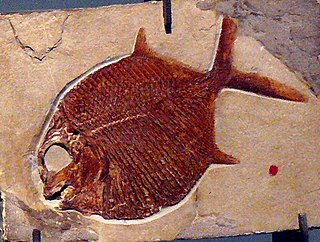
Pycnodontiformes is an extinct order of bony fish. The group evolved during the Late Triassic and disappeared during the Eocene. The group has been found in rock formations in Africa, Asia, Europe, North and South America.

Odontaspis is a genus of sand shark with two extant species.
Crenilepis is an extinct genus of prehistoric bony fish that lived in the seas of present-day Europe during the Anisian stage of the Middle Triassic epoch.
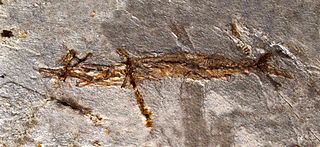
Rhamphognathus is an extinct genus of prehistoric bony fish that lived from the early to middle Eocene.

Acanthonemus is an extinct genus of prehistoric ray-finned fish that lived from the early to middle Eocene.
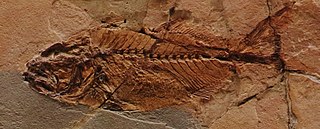
Carangopsis is an extinct genus of prehistoric bony fish that lived from the early to middle Eocene.

Coccolepis is an extinct genus of prehistoric ray-finned fish in the family Coccolepididae. Originally including most species within the family, it is now restricted to two species from the Late Jurassic Solnhofen Limestone of Germany. The holotype of C. bucklandi, designated and described by Louis Agassiz, was thought to be lost but was later rediscovered in Neuchâtel.
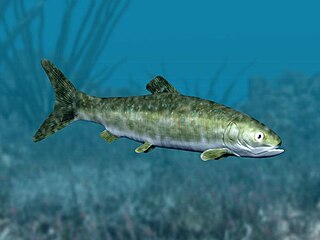
Ichthyokentema ("fish-goad") is an extinct genus of stem-teleost fish that lived during the Late Jurassic. It contains one species, I. purbeckensis, which is known from the Purbeck Group of Dorset, England. I. purbeckensis was originally described as a species of Pholidophorus by William Davies in 1887, but was moved to its own genus by Arthur Smith Woodward in 1941.
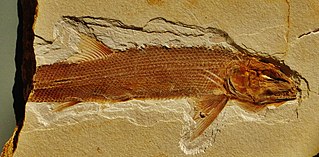
Ophiopsis is an extinct genus of prehistoric ray-finned fish belonging to the family Ophiopsidae. Specimens are known from the Tithonian-age Solnhofen Formation of Bavaria, Germany.
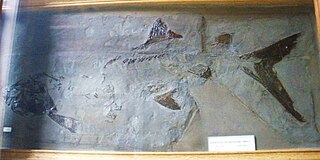
Chondrosteidae is a family of extinct actinopterygian fishes in the order Acipenseriformes. It comprises the Early Jurassic European genera Chondrosteus, Gyrosteus, and Strongylosteus. Included species were of large size, with body lengths ranging from 2 metres (6.6 ft) up to 7 metres (23 ft). Their skeleton was largely made up of bones, but ossification was reduced compared to other ray-fins.

Ophiopsiella is an extinct genus of prehistoric ray-finned fish closely related to the bowfin.
Furo is an extinct genus of ray-finned fish belonging to the order Ioniscopiformes that has been found in Europe. The type species is F. orthostomus.
















